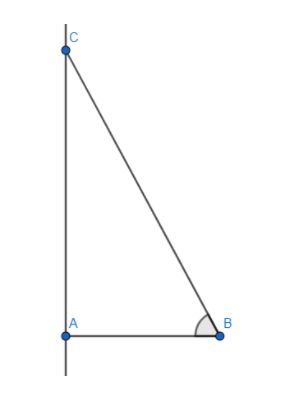
If ${{\sin }^{-1}}\left( \dfrac{5}{x} \right)+{{\sin }^{-1}}\left( \dfrac{12}{x} \right)=\dfrac{\pi }{2}$, the find the value of $x$.
A. $\dfrac{7}{13}$
B. $\dfrac{4}{3}$
C. 13
D. $\dfrac{13}{7}$
Answer
509.1k+ views
Hint: We first use the associative angle formula to find the simplified from. Then we use the trigonometric ratio of the right-angle triangle to find the value of $x$.
Complete step-by-step answer:
We simplify the equation by taking one ratio of sin on the other side
${{\sin }^{-1}}\left( \dfrac{5}{x} \right)+{{\sin }^{-1}}\left( \dfrac{12}{x} \right)=\dfrac{\pi }{2}$.
So,
${{\sin }^{-1}}\left( \dfrac{12}{x} \right)=\dfrac{\pi }{2}-{{\sin }^{-1}}\left( \dfrac{5}{x} \right)$.
Now we take ratio of sine on both sides to get
$\sin \left[ {{\sin }^{-1}}\left( \dfrac{12}{x} \right) \right]=\sin \left[ \dfrac{\pi }{2}-{{\sin }^{-1}}\left( \dfrac{5}{x} \right) \right]$.
We get
$\sin \left[ \dfrac{\pi }{2}-{{\sin }^{-1}}\left( \dfrac{5}{x} \right) \right]=\dfrac{12}{x}=\cos \left[ {{\sin }^{-1}}\left( \dfrac{5}{x} \right) \right]$.
We can take the representation of a right-angle triangle with height and hypotenuse ratio being $\left( \dfrac{5}{x} \right)$ and the angle being $\theta $. The height and base were considered with respect to that particular angle $\theta $.

In this case we take $BC=x$ and keeping the ratio in mind we have $AC=5$ as the ratio has to be $\left( \dfrac{5}{x} \right)$.
Now we apply the Pythagoras’ theorem to find the length of AB. $B{{C}^{2}}=A{{B}^{2}}+A{{C}^{2}}$.
So, $A{{B}^{2}}={{5}^{2}}-{{x}^{2}}$ which gives $AB=\sqrt{{{x}^{2}}-25}$.
We need to find $\cos \left[ {{\sin }^{-1}}\left( \dfrac{5}{x} \right) \right]$ which is equal to \[\cos \theta \].
This ratio gives \[\cos \theta =\dfrac{\text{base}}{\text{hypotenuse}}\]. So,
\[\cos \theta =\dfrac{AB}{BC}=\dfrac{\sqrt{{{x}^{2}}-25}}{x}\].
$\begin{align}
& \cos \left[ {{\sin }^{-1}}\left( \dfrac{5}{x} \right) \right]=\dfrac{12}{x} \\
& \Rightarrow \dfrac{\sqrt{{{x}^{2}}-25}}{x}=\dfrac{12}{x} \\
\end{align}$
Simplification gives ${{x}^{2}}-25={{12}^{2}}=144\Rightarrow x=13$. The correct option is C.
So, the correct answer is “Option C”.
Note: We can also apply the trigonometric image form to get the value of $\cos \left[ {{\sin }^{-1}}\left( \dfrac{5}{x} \right) \right]$.
It’s given that $\sin \theta =\dfrac{5}{x}$ and we need to find \[\cos \theta \]. We know $\cos \theta =\sqrt{1-{{\sin }^{2}}\theta }$.
Putting the values, we get $\cos \theta =\sqrt{1-{{\sin }^{2}}\theta }=\sqrt{1-{{\left( \dfrac{5}{x} \right)}^{2}}}=\dfrac{\sqrt{{{x}^{2}}-25}}{x}$.
Complete step-by-step answer:
We simplify the equation by taking one ratio of sin on the other side
${{\sin }^{-1}}\left( \dfrac{5}{x} \right)+{{\sin }^{-1}}\left( \dfrac{12}{x} \right)=\dfrac{\pi }{2}$.
So,
${{\sin }^{-1}}\left( \dfrac{12}{x} \right)=\dfrac{\pi }{2}-{{\sin }^{-1}}\left( \dfrac{5}{x} \right)$.
Now we take ratio of sine on both sides to get
$\sin \left[ {{\sin }^{-1}}\left( \dfrac{12}{x} \right) \right]=\sin \left[ \dfrac{\pi }{2}-{{\sin }^{-1}}\left( \dfrac{5}{x} \right) \right]$.
We get
$\sin \left[ \dfrac{\pi }{2}-{{\sin }^{-1}}\left( \dfrac{5}{x} \right) \right]=\dfrac{12}{x}=\cos \left[ {{\sin }^{-1}}\left( \dfrac{5}{x} \right) \right]$.
We can take the representation of a right-angle triangle with height and hypotenuse ratio being $\left( \dfrac{5}{x} \right)$ and the angle being $\theta $. The height and base were considered with respect to that particular angle $\theta $.

In this case we take $BC=x$ and keeping the ratio in mind we have $AC=5$ as the ratio has to be $\left( \dfrac{5}{x} \right)$.
Now we apply the Pythagoras’ theorem to find the length of AB. $B{{C}^{2}}=A{{B}^{2}}+A{{C}^{2}}$.
So, $A{{B}^{2}}={{5}^{2}}-{{x}^{2}}$ which gives $AB=\sqrt{{{x}^{2}}-25}$.
We need to find $\cos \left[ {{\sin }^{-1}}\left( \dfrac{5}{x} \right) \right]$ which is equal to \[\cos \theta \].
This ratio gives \[\cos \theta =\dfrac{\text{base}}{\text{hypotenuse}}\]. So,
\[\cos \theta =\dfrac{AB}{BC}=\dfrac{\sqrt{{{x}^{2}}-25}}{x}\].
$\begin{align}
& \cos \left[ {{\sin }^{-1}}\left( \dfrac{5}{x} \right) \right]=\dfrac{12}{x} \\
& \Rightarrow \dfrac{\sqrt{{{x}^{2}}-25}}{x}=\dfrac{12}{x} \\
\end{align}$
Simplification gives ${{x}^{2}}-25={{12}^{2}}=144\Rightarrow x=13$. The correct option is C.
So, the correct answer is “Option C”.
Note: We can also apply the trigonometric image form to get the value of $\cos \left[ {{\sin }^{-1}}\left( \dfrac{5}{x} \right) \right]$.
It’s given that $\sin \theta =\dfrac{5}{x}$ and we need to find \[\cos \theta \]. We know $\cos \theta =\sqrt{1-{{\sin }^{2}}\theta }$.
Putting the values, we get $\cos \theta =\sqrt{1-{{\sin }^{2}}\theta }=\sqrt{1-{{\left( \dfrac{5}{x} \right)}^{2}}}=\dfrac{\sqrt{{{x}^{2}}-25}}{x}$.
Recently Updated Pages
Master Class 11 Economics: Engaging Questions & Answers for Success

Master Class 11 English: Engaging Questions & Answers for Success

Master Class 11 Social Science: Engaging Questions & Answers for Success

Master Class 11 Biology: Engaging Questions & Answers for Success

Class 11 Question and Answer - Your Ultimate Solutions Guide

Master Class 11 Business Studies: Engaging Questions & Answers for Success

Trending doubts
What is meant by exothermic and endothermic reactions class 11 chemistry CBSE

10 examples of friction in our daily life

One Metric ton is equal to kg A 10000 B 1000 C 100 class 11 physics CBSE

Difference Between Prokaryotic Cells and Eukaryotic Cells

What are Quantum numbers Explain the quantum number class 11 chemistry CBSE

1 Quintal is equal to a 110 kg b 10 kg c 100kg d 1000 class 11 physics CBSE




